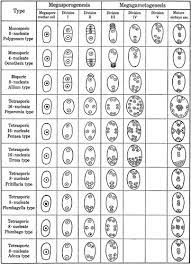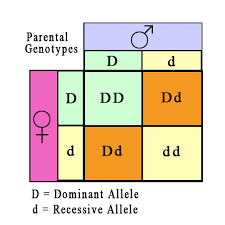embryo sac - types, explanation
TYPES OF EMBRYO SAC
Monosporic
Embryo Sac
The embryo
sac in which only one out of four megaspores is involved in the development of
the embryo sac is called as Monosporic Embryo Sac. Since all the nuclei in such
embryo sac are derived through mitoses of a single nucleus, hence all nuclei
are genetically identical.
On the
basis of number of nuclei in the mature embryo sac, Maheshwari recognised two
types - 8 - nucleate and 4- nucleate.
8- nucleate
or Polygonum type:
This type of embryo sac development was first
discovered in Polygonum divaricatum for the first time by Strasburger, hence it
is called as polygonum type. Since, this is common in Angiosperms(81%), it is
called as normal type. Of the four megaspores formed from the megaspore mother
cell, only one megaspore situated towards chalazal end remains functional and
the remaining three situated towards micropylar end degenerate. The functional
megaspore divides and gives rise to 2 nuclei, one of which moves to the
micropylar pole and called as primary micropylar nuclei and the other moves to
the chalazal pole and is called as primary chalazal nuclei.The second division
produces one pair of nuclei at micropylar and chalazal end. The third division
results in two groups of 4 nuclei at the opposite poles of the elongated embryo
sac. The 4 nuclei towards the micropylar end differentiates into a three celled
egg apparatus and the upper polar nucleus. The 4 cells towards the chalazal end
differentiates into three antipodal cells and the lower polar nucleus. The two
polar nuclei fuse together somewhere in the middle of the embryo sac to give
rise to a secondary nucleus. The egg apparatus at the micropylar endconsists of
two synergids and an egg cell. The other three nuclei at the chalazal end form
the antipodal cells. This type of embryo sac is most common and generally known
as the normal type of embryo sac.
4 –
nucleate or Oenother Type:
Greets in
1908 first discovered a 4-nucleate monosporic type of embryo sac in Oenothera
lamarckiana. Hence it is called as Oenothera type.This type of embryo sac is
formed by the micropylar megaspore of the tetrad. The megaspore nucleus undergo
mitotic division and form two nuclei which remain at the micropylar end. These
two nuclei undergo one mitotic division and form 4 nuclei. Thus megaspore
nuclei undergo only two nuclear divisions instead of the three occurring in the
Polygonum type of embryo sac. Thus, 4 nuclei are produced which organize to
form 4-nucleate embryo sac. Three nuclei remain at the micropylar end and form
an egg apparatus consisting of one egg cell and two synergids. The fourth
nucleus acts as polar nuclei. Since, the third division is omitted and all the
nuclei are situated in the micryopylar end of the embryo sac, there is neither
a lower polar nuclei nor any antipodal cells. This type of embryo sac development
is found to be a characteristic and constant feature of family Onagraceae.
Bisporic
Embryo Sac:
In plants
bearing the bisporic embryo sacs the first meiotic division in the megaspore
mother cell is accompanied by wall formation, so that a dyad is formed. The
upper cell of the dyad is much smaller and soon degenerates. In the functional
dyad cell, the nucleus undergoes second meiotic division to form 2 megaspore
nuclei. Wall formation does not occur after the second division, and both the
megaspore nuclei contribute to the formation of the embryo sac. Since a
bisporic embryo sac is derived from two meiotic division their nuclei belong to
different genetic constitution.
Allium
Type:
The
chalazal dyad cell remains functional and gives rise to a 8 nucleate embryo
sac. Strasburger described for the first time a bisporic embryo sac in Allium
fistulosum. Each megaspore nucleus
undergoes two mitotic divisions forming eight nuclei.The eight nuclei formed
organize similar to the polygonum type.
Endymion
Type:
In this type, the micropylar dyad cell remains
functional and gives rise to a 8 nucleate embryo sac.
Tetrasporic
Embryo Sac:
In this
type of Embryo sac development, the megaspore mother cell undergoes two meiotic
division forming four nuclei. Neither of the meiotic divisions is accompanied
by wall formation so that at the end of meiosis all the four haploid nuclei
remain in a common cytoplasm forming a coenomegaspore. All the four nuclei of the coenomegaspore take
part in the formation of the embryo sac. A tetrasporic embryo sac is more
heterogenous than a bisporic embryo sac because the four nuclei of meiosis are
involved in the formation of the embryo sac are genetically different.
Before the
onset of postmeiotic mitosis, the manner in which the four nuclei in the
coenomegaspore are arranged is of three types:
1) 1+1+1+1 arrangement: one nucleus toward
micropyle, one nucleus toward chalaza and other two placed laterally (one on each
side), eg., Peperomia, Penaea, Plumbago type.
2) 2+2 arrangement: two nuclei toward
micropyle and two towards chalaza, eg.,
Adoxa type
3) 1+3 arrangement: one nucleus toward
micropylar end and three towards the chalaza, eg., Dursa, Fritillaria and
Plumbagella type.
16-nucleate
tetrasporic type:
Peperomia
type:
In this type, as a result of two meiotic
divisions in the megaspore mother cell 4 nuclei are formed. These for nuclei
undergo two mitotic division and form 16 nuclei. Of these 16 nuclei, two nuclei
at the micropylar end become cellular and form egg apparatus consisting of one
egg cell and one synergid. 6 nuclei at the chalazal end become cellular and
form 6 antipodals. The remaining 8 nuclei fuse in the centre of embryo sac and
form secondary nucleus with 8n condition.
Penaea
type:
In this type, as a result of two meiotic
divisions in the megaspore mother cell 4 nuclei are formed. These for nuclei
undergo two mitotic division and form 16 nuclei. These 16 nuclei organise into
4 groups; one group toward micropyle, one group toward chalaza and two groups
lateral (4+4+4+4) arrangement. One nucleus from each group migrate towards the
centre of the embryo sac. They give rise to tetraploid secondary nucleus. The
three nuclei at the micropylar side form egg apparatus by the formation of
walls. It consists one egg cell and two synergids. The remaining 9 nuclei
organize into 3 groups of antipodal cells by formation of septa which are
situated on 3 sides. These are called as triads.
Drusa type:
In this type, as a result of two meiotic
divisions in the megaspore mother cell 4 nuclei are formed. These are arranged
in 1+3 manner. One nucleus at the micropylar end and the remaining 3 nuclei at
chalazal end. These four nuclei undergo two mitotic division and form 16
nuclei. 4 nuclei are present at the micropylar end and 12 nuclei at the
chalazal end. Of the 4 nuclei at the micropylar end 3 nuclei organize and form
egg apparatus. The fourth nuclei function as upper polar nucleus. Among the 12
nuclei at the chalazal end one function as lower polar nuclei. Both upper and
lower polar nuclei move in the centre of embryo sac and form diploid secondary
nucleus. The remaining 11 nuclei at the chalazal end organise into antipodals.
8 - Nucleate Tetrasporic Embryo sac:
Adoxa Type:
It was first studies in Adoxa moschatellina by
Jonsson. Embryo sac is 8 nucleate formed after a single post meiotic mitosis
and has Polygonum type of arrangement. It is also found in Sambucus, Tulipa,
Ulmus etc. In this type, as a result of two meiotic divisions in the megaspore
mother cell 4 nuclei are formed, of these two nuclei are present at each pole. The
four nuclei undergo one mitotic division and form 8 nuclei. Of these 4 nuclei
from the micropylar end 3 nuclei organsie into egg apparatus by the formation
of cell wall and one function as upper polar nuclei.The four nuclei from the
chalazal end 3 nuclei organize into antipodals and one remaining nucleus
function as lower polar nuclei. The two polar nuclei migrate towards the centre
and give rise to a secondary nucleus.
Fritillaria
type:
This type of embryo sac was first observed in
Fritillaria bulbiferum. In this type, as a result of two meiotic divisions in
the megaspore mother cell 4 nuclei are formed, which are arranged in 1+3 manner
i.e., one nuclei at micropylar end and 3 towards the chalazal end. The three
nuclei at chazal end fuse together and form a triploid nucleus. Now the embryo
sac shows only 2 nuclei one haploid nuclei at the micropylar end and one
triploid nuclei at chalazal end. Each nuclei undergo one mitotic division
forming 4 nuclei out of which 2 are haploid nuclei and two are triploid nuclei.
These four nuclei undergo second mitotic division and form 8 nuclei – 4 towards
micropylar end are haploid and 4 towards chalazal end are triploid. Of the four
nuclei at micropylar end, 3 organize
into egg apparatus and one functions as upper polar nuclei. At the chalazal
end, 3 nuclei organize into triploid antipodals and one functions as triploid
lower polar nuclei. The two polar nuclei( one haploid and one triploid move
towards the centre of the embryo sac and form a tetraploid secondary nuclei.
Plumbago
type:
This type of embryo sac was first observed in
Plumbago capensis.In this type, as a result of two meiotic divisions in the
megaspore mother cell 4 haploid nuclei are formed, which are arranged in
1+1+1+1 manner i.e., one nuclei at micropylar end and 1 towards the chalazal
end and remaining two on lateral side, one at each side. These 4 nuclei undergo
mitotic division and form 8 nuclei. Out of 2 nuclei at micropylar end, 1 nuclei
function as egg cell. One nucleus from each side migrate towards the centre and
form a tetraploid secondary nucleus. The remaining 3 nuclei which lie on the
sides forms cell and later degenerate.
4- nucleate Embryosac or Plumbagella type:
It was discovered in Plumbagella micrantha. Four megaspore nuclei are formed as a result of meiosis in megaspore mother cell. These 4 nuclei are arranged in 1+3 manner – one nucleus at the micropylar end and the other 3 at the chalazal end. The three nuclei at chalazal end fuse and form a triploid nucleus. So, there are two nuclei – one haploid nuclei at micropylar end and one triploid nuclei at chalazal end. Now, these two nuclei present at opposite poles undergo mitotic division and form 2 haploid nuclei at micropylar end and two triploid nuclei at chalazal end. Of the two haploid nuclei at the micropylar end one nucleus forms egg cell and other nucleus acts as upper polar nucleus. Of the two triploid nucluei at the chalazal end one acts as lower polar nucleus and other forms an antipodal cell. In the centre of embryo sac the two polar nuclei fuse and form an tetraploid (4n) secondary nucleus. The important characteristic of this type of embryo sac are the presence of one triploid antipodal cell, one egg cell and one tetraploid secondary nucleus. The synergids are absent.



Comments